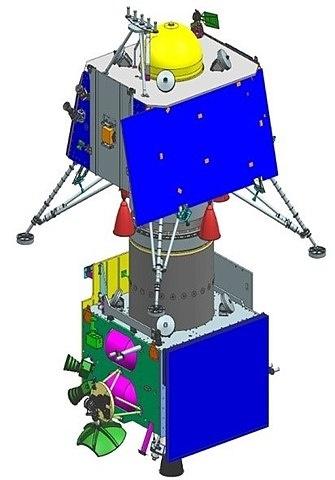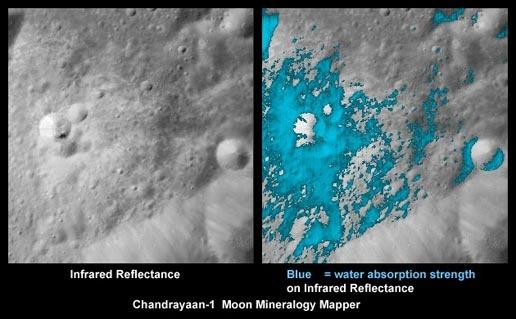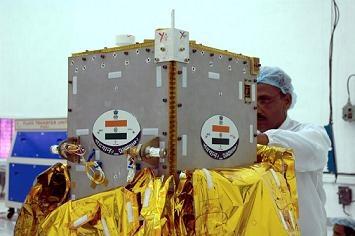
Chandrayaan-2 is the second lunar exploration mission developed by the Indian Space Research Organisation (ISRO), after Chandrayaan-1. It consists of a lunar orbiter, and also included the Vikram lander, and the Pragyan lunar rover, all of which were developed in India. The main scientific objective is to map and study the variations in lunar surface composition, as well as the location and abundance of lunar water.
The spacecraft was launched on its mission to the Moon from the second launch pad at the Satish Dhawan Space Centre in Andhra Pradesh on 22 July 2019 at 09:13:12 UTC by a GSLV Mark III-M1. The craft reached the Moon's orbit on 20 August 2019 and began orbital positioning manoeuvres for the landing of the Vikram lander. The lander and the rover were scheduled to land on the near side of the Moon, in the south polar region at a latitude of about 70° south on 6 September 2019 and conduct scientific experiments for one lunar day, which approximates to two Earth weeks.
However, the lander crashed when it deviated from its intended trajectory while attempting to land on 6 September 2019. According to a failure analysis report submitted to ISRO, the crash was caused by a software glitch. ISRO will re-attempt a landing in 2023 with Chandrayaan-3.
History
On 12 November 2007, representatives of the Roscosmos and ISRO signed an agreement for the two agencies to work together on the Chandrayaan-1's follow-up project, Chandrayaan-2. ISRO would have the prime responsibility for the orbiter and rover, while Roscosmos was to provide the lander. The Indian government approved the mission in a meeting of the Union Cabinet, held on 18 September 2008 and chaired by Prime Minister Manmohan Singh.[18] The design of the spacecraft was completed in August 2009, with scientists of both countries conducting a joint review.
Although ISRO finalised the payload for Chandrayaan-2 on schedule, the mission was postponed in January 2013 and rescheduled to 2016 because Russia was unable to develop the lander on time. In 2012, there was a delay in the construction of the Russian lander for Chandrayaan-2 due of the failure of the Fobos-Grunt mission to Mars, since the technical issues connected with the Fobos-Grunt mission which were also used in the lunar projects including the lander for Chandrayaan-2 needed to be reviewed. When Russia cited its inability to provide the lander even by 2015, India decided to develop the lunar mission independently. With new mission timeline for Chandrayaan-2 and an opportunity for a Mars mission arising with launch window in 2013, unused Chandrayaan-2 orbiter hardware was repurposed to be used for Mars Orbiter Mission.
Chandrayaan-2 launch had been scheduled for March 2018 initially, but was first delayed to April and then to October 2018 to conduct further tests on the vehicle. On 19 June 2018, after the program's fourth Comprehensive Technical Review meeting, a number of changes in configuration and landing sequence were planned for implementation, pushing the launch to the first half of 2019. Two of the lander's legs received minor damage during one of the tests in February 2019.
Chandrayaan-2 launch was scheduled for 14 July 2019, 21:21 UTC (15 July 2019 at 02:51 IST local time), with the landing expected on 6 September 2019. However, the launch was aborted due to a technical glitch and was rescheduled. The launch occurred on 22 July 2019 at 09:13:12 UTC (14:43:12 IST) on the first operational flight of a GSLV MK III M1.
On 6 September 2019, the lander during its landing phase, deviated from its intended trajectory starting at 2.1 km (1.3 mi) altitude,[34] and had lost communication when touchdown confirmation was expected.[35][36] Initial reports suggesting a crash were confirmed by ISRO chairman K. Sivan, stating that "it must have been a hard landing". The Failure Analysis Committee concluded that the crash was caused by a software glitch. Unlike ISRO's previous record, the report of the Failure Analysis Committee has not been made public.
Chandrayaan-2 orbiter performed a collision avoidance manoeuvre at 14:52 UTC on 18 October 2021 to avert possible conjunction with Lunar Reconnaissance Orbiter. Both spacecraft were expected to come dangerously close to each other on 20 October 2021 at 05:45 UTC over the Lunar North pole.
Source: https://en.wikipedia.org/wiki/Chandrayaan-2


